Interesting Facts About King Penguins Babies Definition of
| Quick facts for kids Male monarch penguin | |
|---|---|
 | |
| King penguin Fortuna Bay, South Georgia | |
| Conservation status | |
| | |
| Scientific classification | |
| Genus: | Aptenodytes |
| Species: | patagonicus |
| . | |
| Scarlet: Aptenodytes patagonicus patagonicus Xanthous: Aptenodytes patagonicus halli | |
The king penguin (Aptenodytes patagonicus) is the second largest species of penguin, smaller, but somewhat similar in appearance to the emperor penguin. There are two subspecies: A. p. patagonicus and A. p. halli; patagonicus is found in the South Atlantic and halli in the South Indian Ocean (at the Kerguelen Islands, Crozet Island, Prince Edward Islands and Heard Island and McDonald Islands) and at Macquarie Isle.
King penguins mainly eat lanternfish, squid and krill. On foraging trips, king penguins repeatedly dive to over 100 metres (300 ft), and have been recorded at depths greater than 300 metres (1,000 ft). Predators of the king penguin include behemothic petrels, skuas, the snowy sheathbill, the leopard seal and the orca.
Rex penguins breed on the Subantarctic islands at the northern reaches of Antarctica, Southward Georgia, and other temperate islands of the region.
Contents
- Appearance
- Distribution and habitat
- Ecology and behavior
- Diet
- Predators
- Courting and breeding
- Conservation
- Impact of climatic change
- Resources competition
- Inquiry and direction
- Relationship with humans
- In captivity
- Notable rex penguins
Appearance
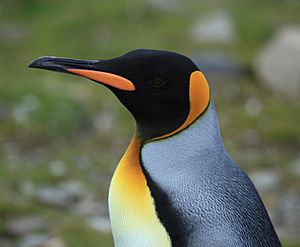
The king penguin stands at 70 to 100 cm (28 to 39 in) tall and weighs from 9.iii to 18 kg (21 to 40 lb). Female person and male rex penguins can exist separated by their calls. Males are also slightly larger than females. The hateful torso mass of adults from Marion Isle was 12.four kg (27 lb) for lxx males and 11.1 kg (24 lb) for 71 females. The king penguin is approximately 25% shorter and weighs effectually 1/3rd less than the emperor penguin.
At first glance, the rex penguin appears very like to the larger, closely related emperor penguin, with a broad cheek patch contrasting with surrounding dark feathers and yellowish-orangish plumage at the top of the chest. However, the cheek patch of the adult rex penguin is a solid vivid orangish whereas that of the emperor penguin is yellow and white, and the upper breast tends to be more orange and less yellowish in the king species. Both have colourful markings along the side of their lower mandible, but these tend towards pink in emperor penguin and orange in rex penguin.
Emperor and rex penguins typically exercise not inhabit the aforementioned areas in the wild, with the possible exception of vagrants at sea, but the two can readily exist distinguished from 1 another by the rex's longer, straighter nib and noticeably sleeker body.
The juvenile king penguin with its heavy brownish downwardly is completely different in advent from the mostly gray emperor chick. Once molted of its juvenile plume, the king chick resembles the developed, but is somewhat less colourful.
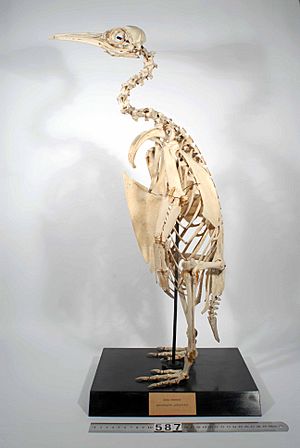
Mounted skeleton of king penguin (Aptenodytes patagonicus)
King penguins often brood on the same large, circumpolar islands every bit at to the lowest degree half of all living penguins, merely information technology is easily distinguished from other species by its much larger size and taller frame, distinctive colorful markings and grizzled sooty-greyish rather than blackish back.
Distribution and habitat
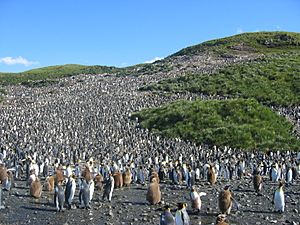
Slap-up colony of king penguins on Salisbury Obviously in Southward Georgia
Rex penguins breed on subantarctic islands between 45 and 55°Southward, at the northern reaches of Antarctica, too every bit Tierra del Fuego, the Falkland Islands, and other temperate islands of the region. The total population is estimated to be 2.23 1000000 pairs and is increasing. The largest breeding populations are on the Crozet Islands, with around 455,000 pairs, 228,000 pairs on the Prince Edward Islands, 240,000–280,000 on the Kerguelen Islands and over 100,000 in the S Georgia archipelago. The King penguin population on South Georgia and the Falklands was nearly wiped out by the early 1920s by whalers on the islands who would eat the birds and their eggs, and fire the oily, blubber rich penguins as fuel. Macquarie Island has around seventy,000 pairs. The non-breeding range is unknown due to many vagrant birds having been seen on the Antarctic peninsula as well as in Southward Africa, Australia and New Zealand.
King penguins appear to have suffered a massive population decline of almost 90% on Île aux Cochons, or Squealer Island in the Crozet Archipelago. Analysing new helicopter and satellite images from 2015 and 2017, the colony's numbers accept dropped to 60,000 breeding pairs. The cause of this decline may exist due to changes in the ecosystem related to climate change every bit their master source of food is moving farther away from places where the penguins can brood. This may effect in population declines and shifts in the locations of the King penguin convenance grounds.
The Nature Protection Society released several king penguins in Gjesvær in Finnmark, and Røst in Lofoten in northern Kingdom of norway in Baronial 1936. Penguins were seen in the area several times during the 1940s; though none take been officially recorded since 1949, there were a few unconfirmed sightings of penguins in the surface area during the early 1950s.
Ecology and beliefs
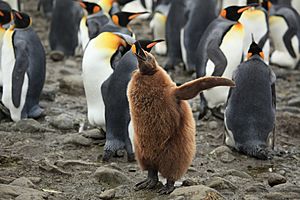
American zoologist Gerry Kooyman revolutionized the written report of penguin foraging behaviour in 1971 when he published his results from attaching automatic dive-recording devices to emperor penguins, and recording a swoop of 235 metres (771 ft) by a king penguin in 1982. The current maximum dive recorded is 343 metres in the Falkland Islands region, and a maximum time submerged of 552 seconds recorded at the Crozet Islands. The king penguin dives to depths of 100–300 meters (350–1000 feet), spending around five minutes submerged, during daylight hours, and less than thirty metres (98 ft) at night.
The majority (around 88% in one study) of dives undertaken by king penguins are flat-bottomed; that is, the penguin dives to a sure depth and remains at that place for a period of fourth dimension hunting (roughly 50% of full swoop time) before returning to the surface. They have been described every bit U-shaped or W-shaped, relating to the course of the dive. The remaining 12% of dives have a Five-shaped or "spike" pattern, in which the bird dives at an angle through the water cavalcade, reaches a certain depth, and then returns to the surface. Using the average pond speed, Kooyman estimated the distance travelled to foraging areas at 28 km (17 mi).
The king penguin'south average swimming speed is 6.5–10 km/h (4–6 mph). On shallower dives under sixty m (200 ft), it averages 2 km/h (i.two mph) descending and ascending, while on deeper dives over 150 thou (490 ft) deep, it averages five km/h (3.1 mph) in both directions. Male monarch penguins as well "porpoise", a swimming technique used to breathe while maintaining speed. On land, the rex penguin alternates between walking with a wobbling gait and tobogganing—sliding over the water ice on its belly, propelled by its feet and wing-like flippers. Like all penguins, it is flightless.
Diet

King penguin moulting, with pin feathers visible
King penguins eat various species of minor fish, squid, and krill. Fish constitute roughly 80% of their diet, except in winter months of July and August, when they make upwardly simply around 30%. Lanternfish are the primary fish taken, principally the species Electrona carlsbergi and Krefftichthys anderssoni, too equally Protomyctophum tenisoni. Slender escolar (Paradiplospinus gracilis) of the Gempylidae, and Champsocephalus gunneri, is likewise consumed. Cephalopods consumed include those of the genus Moroteuthis, the hooked squid or Kondakovia longimana, the sevenstar flying squid (Martialia hyadesii), immature Gonatus antarcticus and Onychoteuthis species.
Predators
The rex penguin's predators include other seabirds and aquatic mammals:
- Giant petrels take many chicks of all sizes and some eggs. They volition also occasionally impale adult king penguins, just very likely mostly sick or injured birds. Giant petrels also scavenge adult king penguins and chicks which accept died from other causes.
- Skua species (Stercorarius spp.) take smaller chicks and eggs. Some studies may have overstated the issue skua predation has on king penguin colonies, but big numbers of chicks and eggs are taken in areas where skua nest close to penguin colonies.
- The snowy sheathbill (Chionis alba) and kelp gull (Larus dominicanus) scavenge for dead chicks and unattended eggs.
- The leopard seal (Hydrurga leptonyx) takes adult birds and fledglings at body of water.
- Orcas also hunt king penguins.
- Male and specially pre-adult male Antarctic fur seals on Marion Isle take also been observed chasing, killing and eating rex penguins on the embankment.
Courting and convenance
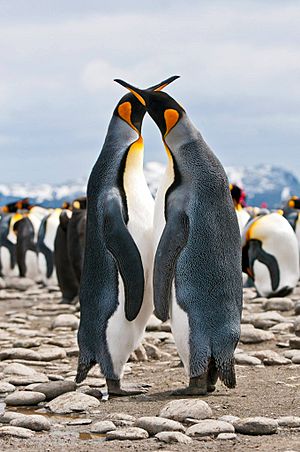
The king penguin is able to breed at 3 years of age, although just a very small minority (5% recorded at Crozet Islands) really do then; the average age of starting time breeding is around 5–6 years. King penguins are serially monogamous. They accept only one mate each year, and stay faithful to that mate. Notwithstanding, fidelity between years is less than xxx%. The unusually long breeding cycle probably contributes to this low rate.
The king penguin has an extremely prolonged convenance cycle, taking effectually 14–xvi months from laying to offspring fledging. Although pairs volition attempt to breed annually, they are generally only successful 1 twelvemonth in two, or 2 years in 3 in a triennial pattern on South Georgia. The reproductive cycle begins in September to Nov, as birds render to colonies for a prenuptial moult. Those that were unsuccessful in breeding the previous season will ordinarily arrive earlier. They and so return to the ocean for around three weeks earlier coming ashore in November or December.
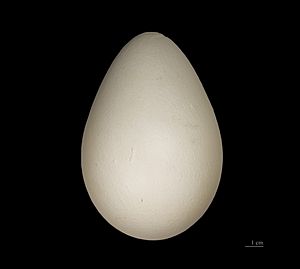
The female penguin lays one pyriform (pear-shaped) white egg weighing 300 g (⅔ lb). It is initially soft, merely hardens and darkens to a stake greenish colour. It measures around 10 cm × 7 cm (three.9 in × 2.8 in). The egg is incubated for around 55 days with both birds sharing incubation in shifts of half dozen–18 days each. Similar the closely related emperor penguin, the king penguin balances the egg on its anxiety and incubates it in a "brood pouch".
Hatching may take upwardly to 2–3 days to complete, and chicks are built-in semi-altricial and nidicolous. In other words, they accept only a sparse covering of downwards, and are entirely dependent on their parents for food and warmth. The guard phase begins with the hatching of the chick. Similar to the emperor penguin, The young male monarch penguin chick spends its fourth dimension balanced on its parents' feet, sheltered in the brood pouch formed from the intestinal skin of the latter. During this fourth dimension, the parents alternating every 3–7 days, one guarding the chick while the other forages for food. The guard phase lasts for thirty–40 days. By then the chick has grown much larger, and is better able to both keep warm and protect itself against most predators. King chicks are very curious and volition wander to explore their surroundings. The chicks course a grouping, called a crèche and are watched over past only a few adult birds; most parents go out their chick in these crèches to forage for themselves and their chick. Other species of penguins as well exercise this method of communal care for offspring.

By April, the chicks are most fully grown, but lose weight by fasting over the winter months, gaining it again during leap in September. Fledging and then takes place in late spring/early summer.
King penguins form huge breeding colonies; for example, the colony on S Georgia Island at Salisbury Plain holds over 100,000 breeding pairs and the colony at St. Andrew's Bay over 100,000 birds. Because of the very long breeding bike, colonies are continuously occupied year-circular with both adult birds and chicks. During breeding, male monarch penguins exercise not build nests, however they show strong territorial behaviour and keep a pecking distance to neighbouring penguins. Penguin positions in breeding colonies are highly stable over weeks and announced regularly spaced, but thus far no quantitative analysis of the structural gild inside a colony has been performed.
The king penguin feeds its chicks past eating fish, digesting it slightly and regurgitating the food into the chick's mouth.
Considering of their large size, king penguin chicks have 14–16 months before they are ready to go to body of water. This is markedly different from smaller penguins, who rear their chicks through a single summertime when nutrient is plentiful. King penguins time their mating so the chicks will develop over the harshest season for fishing. In this way, by the fourth dimension the young penguins are finally mature enough to leave their parents, it is summertime when food is plentiful and conditions are more than favorable for the young to survive alone at sea.
Conservation
Affect of climate change
70% of rex penguins are expected to abruptly disappear in less than eighty years. Considered sensitive indicators of changes in marine ecosystems, rex penguins serve as a fundamental species for understanding the effects of climate change on the marine biome, peculiarly throughout the sub-Antarctic and Antarctic areas.
King penguins primarily feed at the Antarctic Convergence, which provides lxxx% of their food biomass. King penguins currently travel 300–500 km over a course of over a week to complete the journey. However, ocean warming could easily motility these fronts further away from convenance grounds. Continuous ocean warming could crusade the convergence zone to movement polewards, away from king penguin breeding sites like the Falklands and the Crozet Islands. It has been suggested that if carbon emissions continue to rising at their current rate, male monarch penguins will need to travel an additional 200 km in order to reach their feeding areas. Breeding grounds volition also endure with the rise of emissions. Nearly half of the total population will likely lose their convenance grounds past the year 2100.
Resources competition
King penguins are also threatened past large-scale commercial fishing that could deplete their main source of food: myctophid fish. Over 200,000 tons of myctophid fish were commercially exploited by the kickoff of the 1990s in the S Georgia region. Ongoing attempts to further develop this fishery for human consumption shut to fundamental penguin foraging areas are likely to have negative impacts on food provisioning.
Inquiry and management
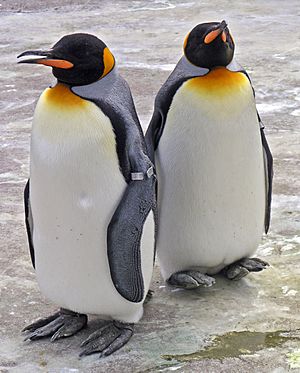
The Pew Charitable Trust recommends the Convention for the Conservation of Antarctic Marine Living Resources (CCAMLR) implement "large-scale, fully protected marine reserves in the waters surrounding Antarctica." The Trust also recommends precautionary management of the Antarctic krill fishery in lodge to protect king penguins' chief source of food. The CCAMLR is made up of 24 countries (plus the European Union), amidst those are the United States and China, that withhold the potency to enact such protective measures. It has also been suggested that in conservation modeling, special attention exist paid to the southernmost breeding locations, given the predicted rise in h2o temperature in the Southern Body of water, and that complete regular censuses of breeding populations be carried out to find temporal trends and ecology changes.
The species is classified equally To the lowest degree Concern past the International Matrimony for Conservation of Nature's Red List of Threatened Species. Since 2004, the IUCN has reported that the population size is large and has increased its breeding rates. Adult king penguins have maintained loftier survival rates since the 1970s. The steady population of king penguins is due largely to current conservation efforts to protect nesting habitats. Ecotourism and public admission to all king penguin convenance sites are heavily restricted in gild to prevent outbreaks of disease and general disturbance. All of the colonies in Crozet and Kerguelen Islands are protected under the oversight of the Reserve Naturelle Nationales des Terres australes et Antarctiques Françaises. Additionally, Due south Georgian penguins reside in a "special protected surface area within the Environmental Management Plan for South Georgia." And in the Falklands, all wild animals—including the rex penguin—is protected under the Conservation of Wildlife and Nature Neb of 1999.
Relationship with humans
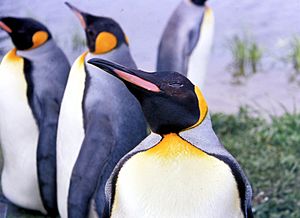
King Penguin Aptenodytes patagonicus
In captivity
Considered a flagship species, 176 individuals were counted in captivity in North American zoos and aquaria in 1999. The species is exhibited at SeaWorld Orlando, Indianapolis Zoo, Detroit Zoo, Saint Louis Zoo, Kansas City Zoo, Newport Aquarium in Newport, Kentucky, Edinburgh Zoo and Birdland in the Uk, Berlin Zoological Garden in Deutschland, Zurich Zoo in Switzerland, Diergaarde Blijdorp in the Netherlands, Antwerp Zoo in Belgium, 63 Seaworld in Seoul, South Korea, Melbourne Aquarium in Australia, Mar del Plata Aquarium in Argentina, Loro Parque in Spain and Ski Dubai in United Arab Emirates, Calgary Zoo in Canada, Odense Zoo in Denmark, Asahiyama Zoo in Hokkaido, Japan, and many other collections.
Notable male monarch penguins
- Brigadier Sir Nils Olav, the Edinburgh-based mascot and colonel-in-chief of the Royal Norwegian Baby-sit
- Misha, a central character and metaphor in 2 novels by Ukrainian author Andrey Kurkov
- The king penguin is likewise the species of penguin represented past the pop grapheme Pondus, an image found on various paraphernalia in many retail stores throughout Canada. Pondus originates in Danish children'due south books written and photographed by Ivar Myrhøj and published in 1997 by Lademann publisher in the tardily 1960s. These penguins appeared in the production of Batman Returns.
- Lala the Penguin became a viral video star afterward an Animal Planet special featured him venturing to a nearby market in Japan to fetch a fish with a peculiarly fabricated backpack. Lala had been accidentally defenseless by a fisherman. The fisherman and his family nursed Lala back to health, then adopted him as a pet.
All content from Kiddle encyclopedia articles (including the article images and facts) tin can be freely used nether Attribution-ShareAlike license, unless stated otherwise. Cite this article:
King penguin Facts for Kids. Kiddle Encyclopedia.
Source: https://kids.kiddle.co/King_penguin

0 Response to "Interesting Facts About King Penguins Babies Definition of"
Post a Comment